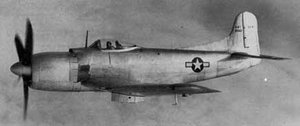AM Mauler
|
|
The Martin AM Mauler was a shipboard attack aircraft of the United States Navy. Designed during the World War II years, the aircraft did not enter production until well after the war after a number of problems. 151 aircraft were built, but they did not last long in Navy service; the smaller and simpler Douglas AD Skyraider (later the A-1) proved to be the superior aircraft. Active-duty squadrons abandoned the Mauler in 1950, and it lasted through 1953 in reserve units.
In the 1930s and very early 1940s, the Navy differentiated between two types of carrier-borne bomber: the torpedo bomber and the dive bomber. In 1943 this distinction was abandoned, and the Navy invited proposals for a new multi-purpose bomber. Unlike previous aircraft, this was to be a single-seater; no separate bombardier or radio operator was deemed necessary, and the plane was intended to be as fast as fighters and thus not need a rear gunner.
For its new BTM-1 Mauler, Martin decided on the Pratt & Whitney Wasp Major 28-cylinder four-row 'corncob' radial engine, the largest piston engine ever to see aircraft service. Around this they designed one of the largest single-engined single-seat combat aircraft ever built. The Wasp Major was so powerful that its torque made the aircraft difficult to fly; its tendency to turn the aircraft was partially offset by pointing it two degrees to the right. Direct controls were not feasible in an aircraft of this size and bulk; instead, a system of hydraulic servos gave the pilot a power assist. All of this meant that the aircraft, originally ordered to assist in the invasion of Japan, was not ready until 1947, though the two prototypes flew in 1944.
Problems with the tail hooks damaging the rear fuselage delayed service entry another year, and it was not until 1948 that they saw operational service. By this time, they bore the Navy's new Attack classification as AM-1. They could carry enormous bombloads; a Martin test pilot flew one bearing three 2,200 lb (1,000 kg) torpedoes, twelve 500 lb (230 kg) bombs, and a full load of ammunition - a total payload of 10,648 lb (4,830 kg), a record at the time for a single-engined aircraft. Bomb loads in carrier service were smaller, though, and the plane gained a mostly-deserved reputation for being hard to land on carrier decks, leading to the nickname of 'Awful Monsters'.
Although the Douglas AD-1 Skyraider was smaller and could not carry as much of a bombload, it proved much more reliable in service and easier to fly and land, and Navy pilots preferred it. In 1950 the decision was made to use the Mauler only from dry land, and later that year all but reserve units abandoned the type. Reserves flew them until 1953.
Four or so survive; the plane that set the payload record is preserved at the National Museum of Naval Aviation in Pensacola, Florida, while a number of less complete examples survive also. One of these, belonging to the Commemorative Air Force (formerly the Confederate Air Force) was kept in flying condition until the 1980s.
| Related content | |
|---|---|
| Related Development | |
| Similar Aircraft | A-1 Skyraider - TB2D Skypirate |
| Designation Series | AM Mauler |
| Related Lists | List of military aircraft of the United States |
|
Lists of Aircraft | Aircraft manufacturers | Aircraft engines | Aircraft engine manufacturers Airports | Airlines | Air forces | Aircraft weapons | Missiles | Timeline of aviation |

